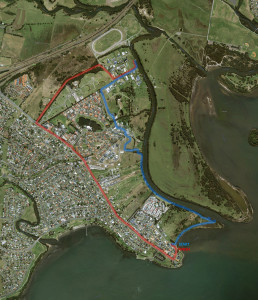
It has taken me almost two months to write about our walk along Mullet Creek largely because my impressions of the experience, rather than free-flowing, remain clunky and turgid. But perhaps this is apt – so physically fragmented and dislocated was the tract of land we walked that day.
From our meeting place on Murra Murra road, overlooking Purrah Bay Park, we walked to the mouth of the creek where it meets Lake Illawarra, and then upstream almost as far as its intersection with the Princes Motorway. A large detour through suburbia – during which we crossed several tributaries of the Mullet – ended with a late lunch by the creek proper before our return walk along Valley Way and Kanahooka Road.
To walk upstream from the mouth of a waterway should of course be only as challenging as its ‘natural’ aspects dictate: the incline of the terrain, the compactness of its vegetation. And yet a good part of our time alongside the creek was spent negotiating barb wire fences, potentially electric fences, eroded channels, cement boat ramps, and a perfectly rounded grassy hillock (presumably sculpted from land fill). The creek itself figures little in my memory. As such, I couldn’t help but wonder what Mullet Creek was like before it was infringed upon by modernity.
A quick internet search revealed that at least two paintings were made of Mullet Creek in the nineteenth century by visiting European artists – by Conrad Martens in 1853, and by Valentine Delawarr in the later part of the century. Their dark palettes and absence of man-made subject matter epitomise the romantic sensibilities of landscape painting at the time.
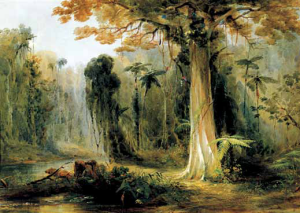
Watercolour and pencil, 30 x 43 cm
In my initial contemplation of these pictures I was inclined to think they were of locations further upstream from any point we reached on our walk, as the vegetation depicted seemed too lush for an estuarine environment. But contemporaneous sketches of the greater Dapto area, made by George French Argas, testify to the already compromised nature of this part of the Illawarra. Stripped of much of its original vegetation, land had been quickly divided into a patchwork of farming properties. A close inspection of Eugene von Guérard’s famous oil painting, View of Lake Illawarra with distant mountains of Kiama, 1860, suggests that some of the largest intact forests in this area were at the mouth of Mullet Creek; so it is quite possible that we walked in the footsteps of Conrad and Delawarr after all.
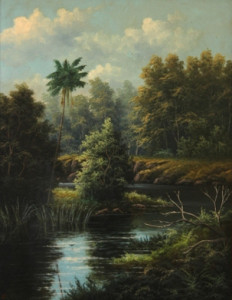
For romantic landscape painters arriving from Europe in the colonial era, Port Jackson offered little in the way of desirable subject matter. So alien was its sandstone soils and dry sclerophyll vegetation that artists sought out the sublime vistas of the Blue Mountains to the west, and the lush rainforests of the Illawarra to the south (Organ 1993). It would not be until the advent of en plein air – championed by the Heidelberg school in the later part of the century – that a painting style would popularly evoke Sydney’s unique character. And yet, as Impressionism remained an intrinsically bourgeois predilection, both in subject matter and execution (Hughes 1980, p.113), it was arguably the harbour’s modernisation that made it so evocative. With its industries, steamers, sailing boats, and beach goers, the harbour had modernised as both experience and spectacle. What proved taciturn for the Romantics was made expressible only because it had been completely transformed.
I emphasise this idea of modernity, and the way it has been engaged with visually, because as I think back to our walk along Mullet Creek, and look through the photographs I took, those most prevailing characteristics of the modern epoch – fragmentation and alienation – cannot be ignored. Never have so many people lived along Mullet Creek, yet the fences and storm water channels that almost bifurcate this waterway emphasise the disconnect between each property and the individuals that reside there. If you were ever in doubt about the official status of your whereabouts, ‘private property’ signs (trespassers will be prosecuted) are readily at hand to remind you.
This is only emphasised more as one moves further upstream, as horse paddocks give way to newer housing estates. With land in the Illawarra now at a premium, the gaudiness of these ‘McMansions’ is matched only by their claustrophobic proximity to each other; the faux grandeur of their colonnades and balustrades operatically unveiled to the cacophony of barking dogs. Here, the Illawarra escarpment is the mere cornice of a white room offering unimpinged views of a plasma TV screen. Only the occasional tributary – either highly manicured into ponds, or eroded channels marking the boundary of one paddock from another – indicate nature is still nearby.
My point, of course, is that it is difficult to reconcile any part of Mullet Creek we might have walked that day in September with the aforementioned nineteenth century visions of Conrad or Delawarr. Whatever had initially inspired the misanthropic eye of the romantic painter is now largely gone. The once exotic vegetation that attracted artists to the Illawarra is the very same phenomena that lured farmers and graziers – the forests for their timber, the rich alluvial soil of the coastal flood plain for its agricultural potential. As such, while landscape painters might have been lured by the region’s ‘natural’ beauty, many of them made their living by documenting its eradication: picturesque property-scapes, commissioned by land holders, testify to the process by which unruly nature was brought to heel by western civilisation. The irony of this situation was not lost on the artists themselves. Commenting on the intensive logging taking place in the region, von Guérard wrote:
“Unfortunately the progress of settlement is necessitating the destruction of these magnificent forests, which in many instances clothe a rich chocolate soil of especial value to the farmer … [S]tately giants [are] rapidly falling before the pitiless axe of the hardy pioneers of civilisation.” – cited in Mills & Jakeman 1995, p.28
Vestiges of any original estuarine environment along Mullet Creek are represented almost totally by copses of Black she-oak. Prominent and more naturally dispersed at the mouth of the creek, they then trail in almost single formation upstream – somewhat reminiscent of the tree-lined canals of Europe. At this time of year their golden brown fruit were in abundance, and they glistened in the spring sunshine as if sprinkled with gold dust. These are the sights from our walk that most pleased me.
At one point we stumbled across a ramshackle tin shed that looked directly out onto the creek, its sole contents being two ragged deckchairs. With a view of the opposite bank, lined with golden she-oak, it pleased me to think that even such a haphazard approach to modern leisure meant that a few residents had, at least sometime in the recent past, been able to appreciate the subtle beauty still discernible along this waterway – albeit a mere shard from a now fragmented picture.
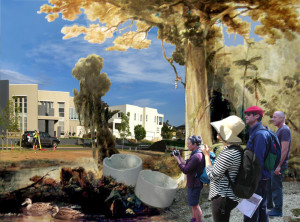
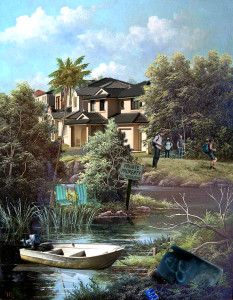
Works cited
Hughes, R 1980, The Shock of the New: Art and the Century of Change, British Broadcasting Corporation, London.
Mills, K & Jakeman, J 1995, Rainforests of the Illawarra District, Coachwood Publishing, Jamberoo.
Organ, M 1993, Conrad Martens and Illawarra 1835-1878: In search of the Picturesque, Illawarra Historical Publications, Wollongong.

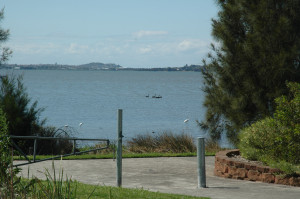
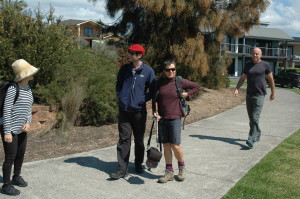
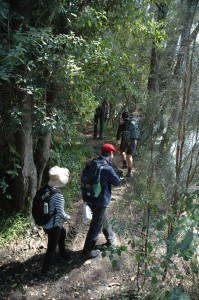
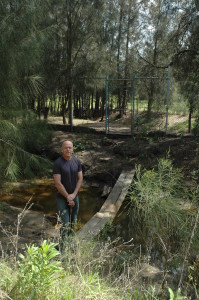
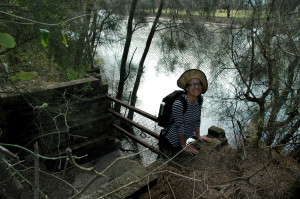

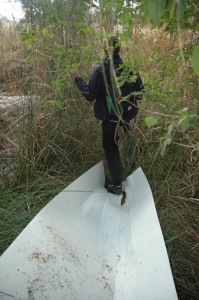
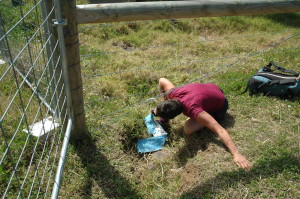
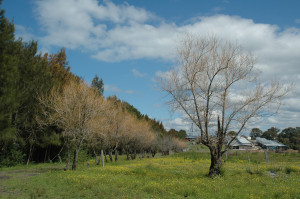
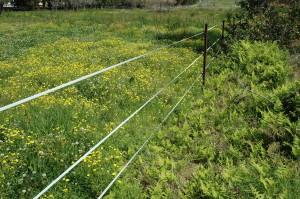

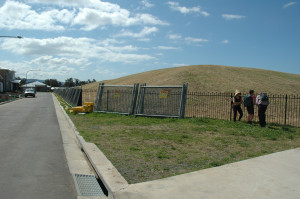
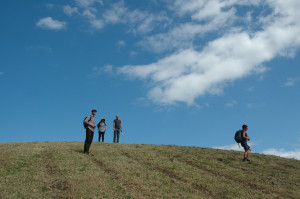
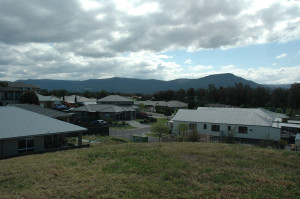
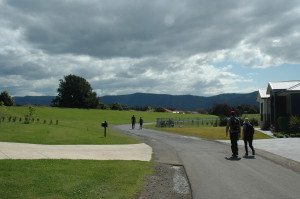
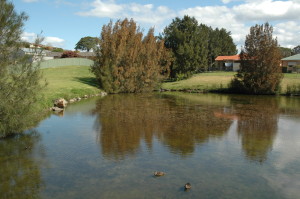
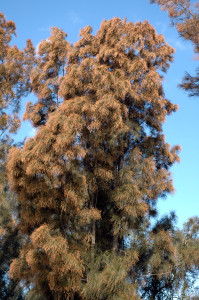

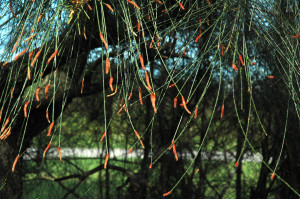
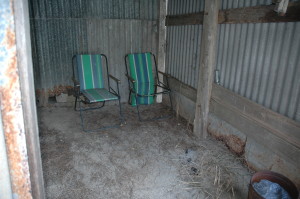
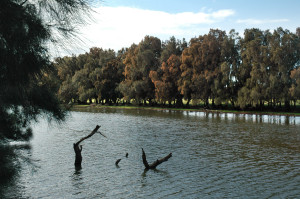
Love you to visit Dapto HS; we have a 2.5km frontage to Mullet Creek; we are now promoting the idea of renaming our section ‘Karrara’; the Indigenous naming.
Our school is particularly focussed on using our magnificent site to promote good learning, teaching and mental health.